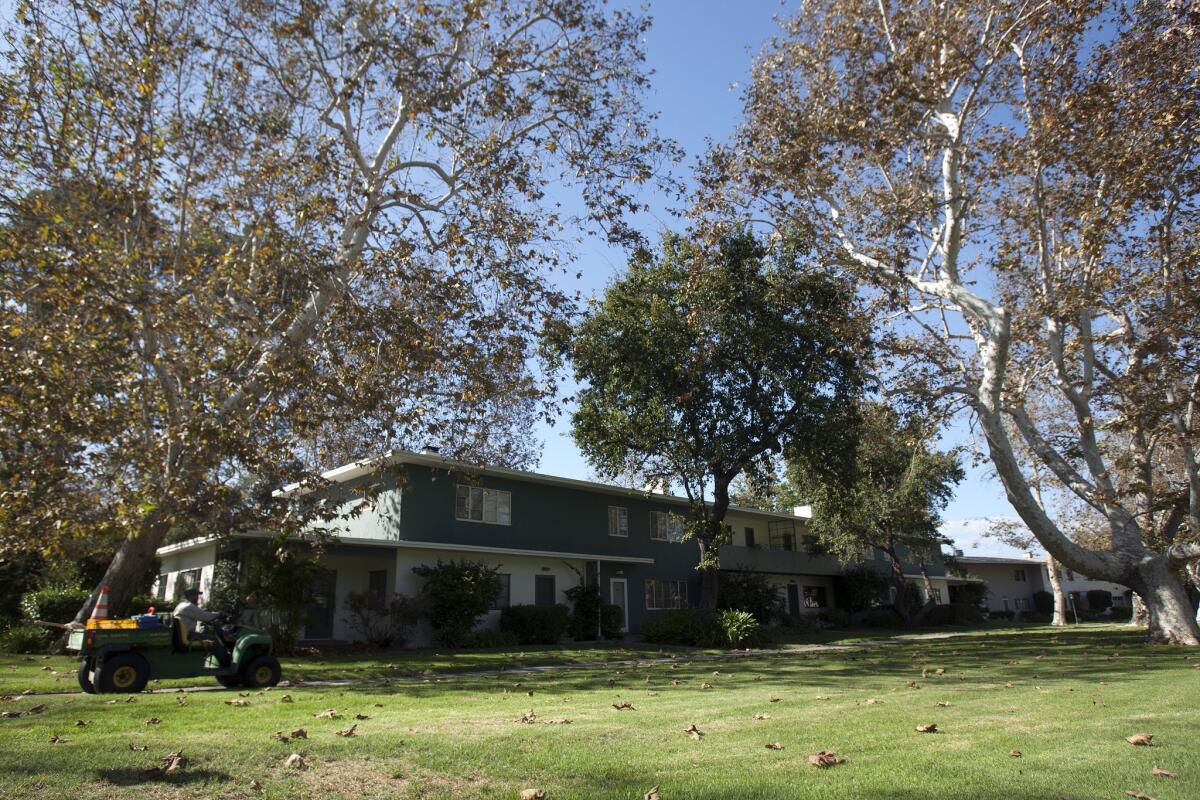L.A. a fertile ground for garden apartments

As you drive around L.A., you may not notice them, but the city’s garden apartment complexes are worth notice. Park La Brea, adjacent to the Los Angeles County Museum of Art, may be the most recognized of the complexes — and one of the largest, at 150 acres — but there are at least 40 in the L.A. area alone. The purest expression of the style, the 68-acre, lovingly maintained Village Green at the foot of Baldwin Hills, is a National Historic Landmark, the highest level of recognition given by the National Park Service.
Garden apartments, born of the late 19th century garden city movement in England and developed from the late 1930s through the mid-1960s, shared the same basic characteristics: affordable, low-rise, low-density, modest units clustered on large tracts of land, with an emphasis on landscaping over buildings, generous open public greenswards and restricted automobile traffic. The concept found particularly fertile soil in Los Angeles in the 1940s and 1950s, when an urgent need to replace festering slums, coupled with a war-fueled influx of defense industry workers, spiked a demand for low- to moderate-cost housing. That need grew substantially after World War II, as returning GIs looked for places to start their families.
Hoping to spotlight the unique nature of the city’s garden apartments, the L.A. Conservancy is hosting a daylong tour of three notable examples — the revitalized 1948 Chase Knolls in Sherman Oaks, the similarly redone 1951 Lincoln Place in Venice and the 1941 Village Green — on Nov. 1. The event starts with an hour-long introduction at the Wilshire Ebell Theatre, after which participants can visit three garden apartments, in any order. On-site docents will give hour-long tours throughout the day.
Garden apartments “were perfectly suited to Los Angeles, specifically at that time, when there was still an abundance of open land,” says architectural historian Katie Horak of the Architectural Resources Group, which was commissioned recently by residents of Village Green to create a historic structures report for guidance. “They were so well-adapted to our climate, where people could spend a lot of time outside all year round.” So critical was the parkland quality of these complexes, she adds, that she “was really astonished to find that the landscape architect was paid more than the architect. They placed the buildings to take advantage of the landscape.”
Garden apartments, however, were never simply about creating shelter. They were about creating community amid the sprawling L.A. Basin. “It really is a little village in a big city,” says Adrian Scott Fine, the Conservancy’s director of advocacy. “There were large lawns on which you’d interact with one another. You got to know your neighbors. Some people have lived in these places for generations. They were and are still a great place to live.”
Garden apartments were considered progressive urban planning in their day — and during the McCarthy era in the 1950s, suspiciously communal by some (due in part to either direct financial support from the federal government or Federal Housing Administration-backed loans), which put a temporary brake on their development. “They are the absolute democratic housing type,” says Horak. “There was a premium on houses actually facing shared outdoor space. They were marketed as a way of life.”
It’s a way of life that is coming increasingly under attack, however. Large tracts with low density are a tantalizing combination for developers who might want to increase density — and profits. Residents and proponents of the large tract-low density model, such as the Conservancy, are seeking historic and other preservation designations to prevent their loss. The current poster child is the 70-acre 1939 Wyvernwood in Boyle Heights, where developers are looking to raze the 150-building, 1,200-unit complex and replace it with 4,000 units, ranging from studios to two-bedroom apartments.
The Conservancy hopes that drawing visitors onto the apartment grounds will open their eyes. “That’s what we are encouraging — get out of your cars, come in and see these places firsthand,” Fine says. “It really is like a little discovery. People say, ‘These are an amazing resource, who knew?’”
::
‘We Heart Garden Apartments! Tour’ info
The Los Angeles Conservancy will host its “We Heart Garden Apartments!” tour on Nov. 1 from 10 a.m. to 4:30 p.m. Ticket prices range from $10 to $35. For more information and registration, visit https://www.laconservancy.org/gardentour.